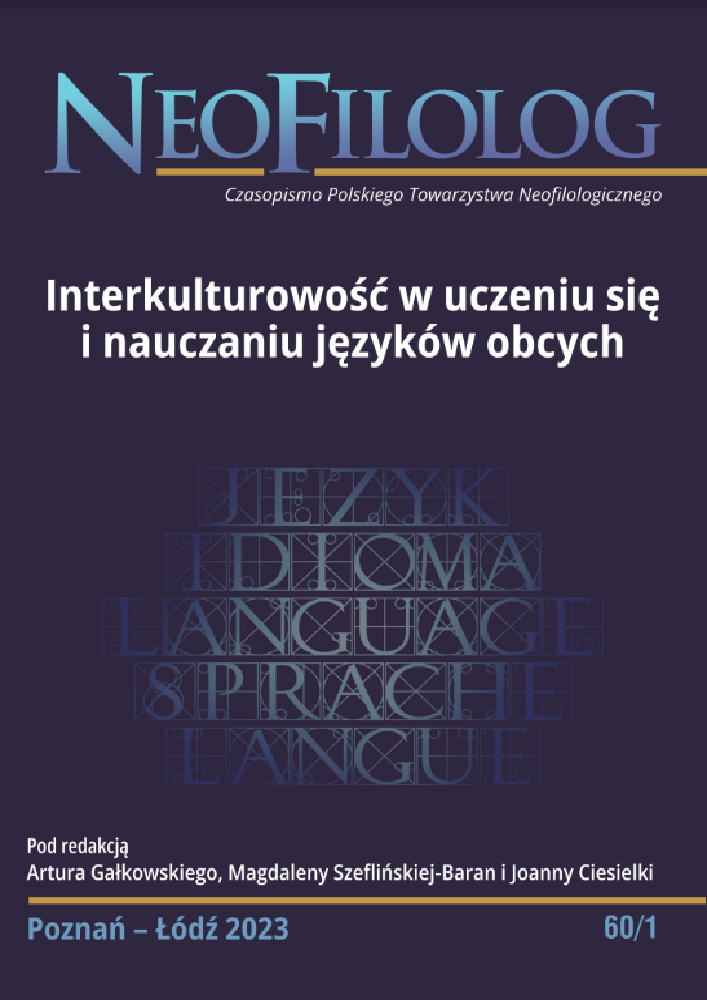Abstract
The shift to distance learning in foreign languages teaching has further emphasized the need for communication and interaction set in a context close to authentic experience. The starting point of the research was the assumption that a new classroom practice developed during the pandemic –the “language space bridge” – contributes to the development of language education and influences the improvement of intercultural competence. This article is based on a study of the “language space bridge”, a non-institutional educational platform running between 2020 and 2022 and set up by an international team of foreign language teachers collaborating under an Erasmus+ project. The article discusses theoretical aspects of intercultural communication and forms of training. A description of the research process is followed by the presentation of the didactic process itself. Having conducted an in-depth analysis of the evaluation questionnaires completed by the students and teachers, the authors conclude that the new educational platform might be a way to improve intercultural competence for both students and teachers.
References
Aleksandrowicz-Pędich L. (2007), Interkulturowość w kształceniu językowym w Polsce i innych krajach europejskich, (w:) Nauczanie języków obcych – Polska a Europa (red. Komorowska H.), Warszawa: Wydawnictwo SWPS, s. 39–56.
Bandura E. (2007), Nauczyciel jako mediator kulturowy. Kraków: Wydawnictwo Tertium.
Byram M., Zarate G. (1994), Definitions, objectives and assessment of socio-cultural competence. Strasbourg: Council of Europe.
Byram M. (1997), Teaching and Assessing Intercultural Communicative Competence. Clevedon: Multilingual Matters.
Chomsky N. (1957), Syntactic structures. Hague: Mouton & Co. DOI: https://doi.org/10.1515/9783112316009
ESOKJ-Europejski system kształcenia językowego: uczenie się, nauczanie, ocenianie (2001), Warszawa: CODN.
ESOKJ-Europejski system kształcenia językowego: uczenie się, nauczanie, ocenianie (2020): online: https://rm.coe.int/common-european-framework-of-reference-for-languages-learning-teaching/16809ea0d4 [DW 26.07.2022].
Grucza F. (1976), Lingwistyczne uwarunkowania glottodydaktyki, (w:) Grucza F. (red.), Glottodydaktyka a lingwistyka. Warszawa: Wydawnictwo Uniwersytetu Warszawskiego, s. 7–25.
Grucza F. (1992), Kulturowe determinanty języka oraz komunikacji językowej, (w:) Grucza F. (red.), Język, kultura – kompetencja kulturowa. Materiały z XII Sympozjum ILS UW (Zaborów, 5-8 listopada 1987). Warszawa: Wydawnictwa Uniwersytetu Warszawskiego, s. 9-70.
Mihułka K. (2014), Dylematy współczesnej glottodydaktyki: język – kultura, interlingwalizm – interkulturowość. „Języki Obce w Szkole”, nr 3, s. 78-87.
Mihułka K. (2012a), Rozwój kompetencji interkulturowej w warunkach szkolnych. Mity a polska rzeczywistość. Rzeszów: Wydawnictwo Uniwersytetu Rzeszowskiego.
Mihułka K. (2012b), Sposoby rozwijania kompetencji interkulturowej na lekcji języka obcego. „Języki Obce w Szkole”, nr 2, s. 106-117.
Matsumoto D., Yoo S. H. (2006), Toward a new generation of cross-cultural research. „Perspectives on Psychological Sciences”, nr 1(3), s. 234–250. DOI: https://doi.org/10.1111/j.1745-6916.2006.00014.x
Róg T. (2017), Teoria w pigułce. Zestaw 10. Zeszyt 1, online: http://www.bc.ore.edu.pl/Content/996/JO_10_1.pdf [DW 09.01.2023].
Sapir E. (1921), Language: An Introduction to The Study of Speech. New York: Harcourt, Brace & World Inc.
Siek-Piskozub T. (2012), Międzykulturowa kompetencja komunikacyjna wyzwaniem dla glottodydaktyki. „Lingwistyka Stosowana”, nr 5, s. 95–108.
Wilczyńska W. (2005), Czego potrzeba do udanej komunikacji interkulturowej, (w:) Mackiewicz M. (red), Dydaktyka języków obcych a kompetencja kulturowa i komunikacja interkulturowa. Poznań: Wydawnictwo Wyższej Szkoły Bankowej, s. 15-27.
Wilczyńska W., Mackiewicz M., Krajka J. (2019), Komunikacja interkulturowa. Wprowadzenie. Poznań: Wydawnictwo Naukowe UAM.
License
Copyright (c) 2023 Marta Wojakowska, Wojciech Sosnowski

This work is licensed under a Creative Commons Attribution-NoDerivatives 4.0 International License.
Authors
Authors of texts accepted for publication in Neofilolog are required to complete, sign and return to the Editorial team’s office the Agreement for granting a royalty-free license to works with a commitment to grant a CC sub-license.
Under the agreement, the authors of the texts published in Neofilolog grant Adam Mickiewicz University in Poznań a non-exclusive, royalty-free license and authorize the use of Attribution-NoDerivatives 4.0 International (CC BY-ND 4.0) Creative Commons sub-license.
The authors retain the right to the free disposal of the work.
Users
Interested Internet users are entitled to use works that have been published in Neofilolog since 2017, under the following conditions:
▪ attribution – obligation to provide, together with the distributed work, information about the authorship, title, source (link to the original work, DOI) and the license itself.
▪ no derivatives – the work must be preserved in its original form. Without the author's consent, it is not possible to distribute the modified work in the form of translations, publications, etc.
Copyrights are reserved for all texts published since 2017.
Miscellaneous
Adam Mickiewicz University in Poznań retains the property right as a whole (layout, graphic form, title, cover design, logo etc.).

